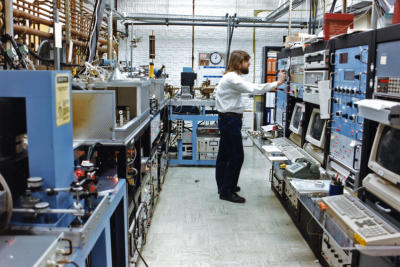The history of noble gas mass spectrometry at LLNL spans more than three decades. Commissioned to support nuclear diagnostics for the underground nuclear test program, the facility originated with Livermore scientist Doug Leich installing a Nuclide 6-60 mass spectrometer in 1978. Seven years later, Doug Leich and Carol Velsko installed a Nuclide 6-90 mass spectrometer, and in 1989 Bryant Hudson and Marc Caffee installed a pair of VG 5400 mass spectrometers. With academic backgrounds in physics, chemistry, and planetary sciences, research interests amongst the scientists were cross-disciplinary, a characteristic that is evident in their diverse publication records. Although not directly involved with daily operations in the noble gas lab, Doug Phinney and Sid Niemeyer were also active at Livermore during this time.
Following the termination of the nuclear test program in 1992, the group's focus shifted towards national security concerns and basic energy and environmental science research. The next decade featured influential papers on nuclear explosion monitoring in support of the comprehensive test ban treaty (Carrigan et al., 1996) and on terrestrial volatile reservoirs (Caffee et al., 1999). Applications of noble gases to cold fusion research (e.g., Morrey et al., 1990), basic nuclear science (e.g., West et al., 1993), and cosmic ray exposure dating (e.g., Seidl et al., 1997) were also emphasized, amongst a variety of groundwater characterization, age dating, and tracer studies.
By the turn of the century, research in the lab increasingly centered on basic energy science, environmental monitoring, and nuclear diagnostics in support of the National Ignition Facility (NIF), with publications highlighting applications of noble gases to carbon sequestration research (e.g., Nimz and Hudson, 2005) and water quality research (e.g., Hudson et al., 2002). The sole functioning VG 5400 is currently dedicated to environmental monitoring and groundwater tracer studies, under the supervision of Ate Visser.
Completion of the NIF in 2009 prompted the acquisition of a new noble gas mass spectrometer at LLNL. Recognizing the potential for synergies between the nuclear forensics program in the Nuclear and Chemical Sciences Division and nuclear diagnostics at NIF, the planning for and purchase of a Nu Instruments Noblesse began in 2011 under the direction of Carol Velsko. In 2012, Bill Cassata was hired to install and manage this mass spectrometer. Over the ensuing years the research portfolio in the lab evolved to include a broad array of topics at the intersection of national security and cross-disciplinary basic science. To support the growth of the laboratory, a second multi-collector noble gas mass spectrometer was installed in 2018. In 2022, Greg Balco was hired to further expand the research portfolio in the noble gas laboratory.
References
Caffee, M.W., Hudson, G.B., Velsko, C.A., Huss, G.R., Alexander, E.C., Chivas, A.R., 1999. Primordial noble gases from Earth's mantle: identification of a primitive volatile component. Science 285, 2115–2118.
Carrigan, C.R., Heinle, R.A., Hudson, G.B., Nitao, J.J., Zucca, J.J., 1996. Trace gas emissions on geological faults as indicators of underground nuclear testing. Nature 382, 528–531.
Hudson, G.B., Moran, J.E., Eaton, G.F., 2002. Interpretation of tritium-3He groundwater noble gas results from public water supply wells in the Los Angeles physiographic basin, Report to the California State Water Resource Control Board.
Morrey, J.R., Jones, R.H., Wacker, J.F., Caffee, M.W., Hudson, G.B., Ruiz, B.V., Farrar, H., Oliver, R.M., Hoffman, N.J., Kurz, M.D., 1990. Measurements of helium in electrolyzed palladium. Fusion Technology 18, 659–668.
Nimz, G.J., Hudson, G.B., 2005. The use of noble gas isotopes for monitoring leakage of geologically stored CO2, in: Thomas, D.C., NBenson, S.M. (Eds.), Carbon dioxide capture for storage in deep geologic formations: Results from the CO2 Capture Project. Elsevier, pp. 1113–1128.
Seidl, M.A., Finkel, R.C., Caffee, M.W., Hudson, G.B., Dietrich, W.E., 1997. Cosmogenic isotope analyses applied to river longitudinal profile evolution: Problems and interpretations. Earth Surface Processes and Landforms 22, 195–209.
West Jr, H.I., Nuckolls, R.M., Hudson, B., Ruiz, B., Lanier, R.G., Mustafa, M.G., 1993. Bromine and iodine excitation-function measurements with protons and deuterons at 3–17 MeV. Physical Review C 47, 248.





